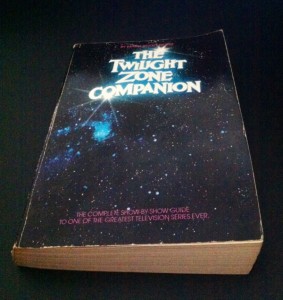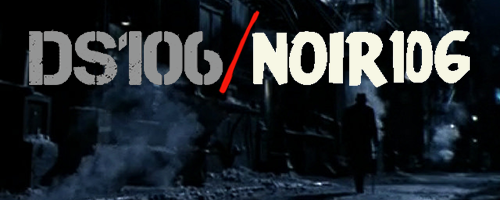Just not in so many words.

“You Best Clear Offa My Roof!” animated GIF, by aforgrave, The Twilight Zone, Season 2, Episode 15, “The Invaders”
Some Thoughts:
- The actress in this role is none other than Agnes Moorehead, whom I remember from Bewitched where she played Endora, Samantha’s overbearing mother. (Poor Darren!)
- The Rod Serling walk-into-frame opening is classic. Right out of the theatre.
- Moorehead’s movements are very stage-like, larger than life — and as the (play) episode moved along, I gradually came to realize that she had been carrying the role without speaking. (There’s a nice vignette in The Twilight Zone Companion which describes Moorehead questioning the director Douglas Heyes, “I’ve been reading the script and I’ve been trying to find my part …”) In fact, she speaks not a single word throughout — saving the voice/english for the “aliens” so we can realize that she, in hindsight, is the non-human, and that “The Invaders” are the ones from Earth.
- The music in the piece just before The Invaders’ spacecraft engine is heard is really haunting. Thanks, Jerry Goldsmith! (Yeah, the same.)
- For someone who lives alone, that’s one heck of a pot of stew she’s cooking up. It’s huge!
- Yeah, I thought I recognized the spaceship from Forbidden Planet!
- When she was trying to get The Invaders out of her house, it felt as if she was fending off mice or rats. Either that, or some neighbourhood kids who were teasing the crazy old lady with remote controlled robots. Except when they were clearly being “walked” by an unseen hand. They didn’t look remote control then.
- As she inspected her hand and arm after the first attack, I was thinking about radiation burns. That was still a big unknown (and therefore scary) thing in the early sixties.
One of the most fascinating aspects of these old teleplays is the significant number of episodes that are carried by a single character — and that character is typically isolated from the rest of the world by their experience. This probably makes it easier for us to identify with the character and therefore assume their emotions, which helps us to get the message of the film. But those notions of isolation, the other, the alien, these are pervasive in The Twilight Zone.
So far, I’ve watch the following:
- Episode 1.1: Where is Everybody? (Earl Hollman, alone and isolated for pretty much the whole episode)
- Episode 1.9 Perchance to Dream (one lead, who refuses to sleep for fear of a recurring dream, and 5 supporting characters)
- Episode 1.16 The Hitch Hiker (one character driving alone across the country, with first-person internal dialogue, and 6 supporting characters)
- Episode 2.1 King 9 Will Not Return (one character, alone and isolated for pretty much the whole episode)
- Episode 2.7 Nick of Time (two main characters, plus supporting characters)
- Episode 2.15 The Invaders (one character, alone and isolated)
- Episode 2.21 The Prime Mover (ensemble)
- Episode 2.26 Shadow Play (Dennis Weaver, on Death Row, with several other characters, plus a jury! But man, he’s isolated, for sure!)
- Episode 2.27 The Mind and the Matter (mostly one lead, once he wishes the rest of the world away!)
- Episode 3.8 It’s a Good Life (ensemble)
There are some interesting notes in The Twilight Zone Companion about the lighting in this episode, and I must say that I did notice the lighting as I was watching — in part because the lanterns and the candles play an integral role in only revealing part of the set and thus adding to the suspense that comes from The Dark. It was almost like The Dark (the unknown) was yet another character. (The book talks about how the lighting crew had to change multiple lights up and down during each scene as Moorehead moved throughout the set carrying her candle — as she moved in and out of doorways they had to ensure that she remained lit for the camera. Interesting.)
So, yeah! Great to see the #ds106zone off and running. Time to do some design and camera stuff. And other stuff, too.
#4life.





























I love how your GIF emerges from black and resolves back – great work. I have all chapters of the TZ Companion in audiobook throughout the next few weeks on #ds106radio http://ds106rad.io/widgets/week
The lighting in The Invaders is quite dark, and I wrestled with the idea of starting with an all-black screen. For a while I considered starting/ending one frame later in the sequence — where the trap door would be open a bit. In the end, I decided that starting and stopping with the door fully closed would be better, and so aside from the pause when it looks like there is nothing happening on within the frame, there is the added surprise effect of the door popping open — and then closing again.
I’ve definitely been enjoying The Twilight Zone radio episodes on ds106radio, as well as the television shows, and am looking forward to hearing and seeing more! Yay for ds106radio!